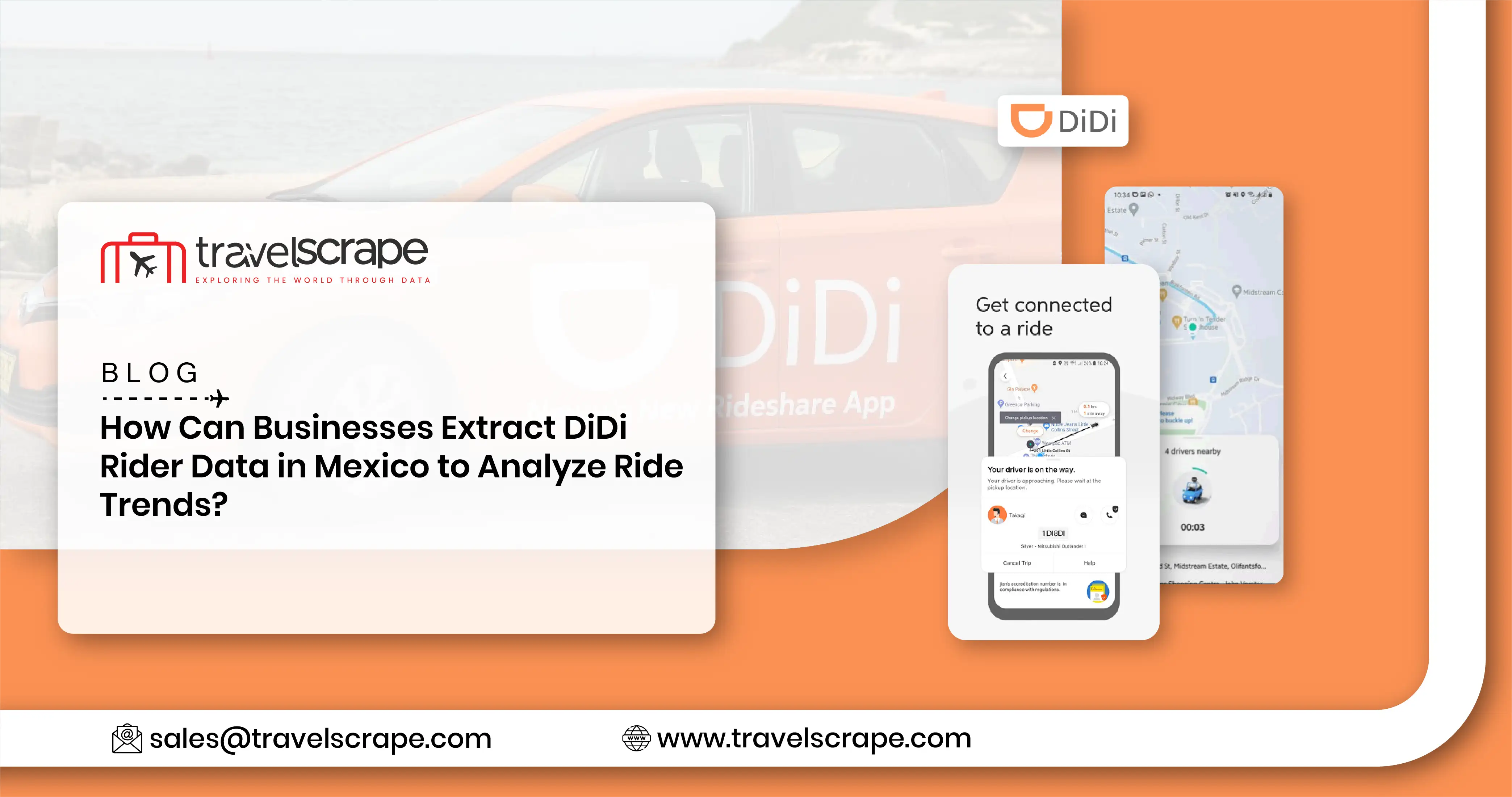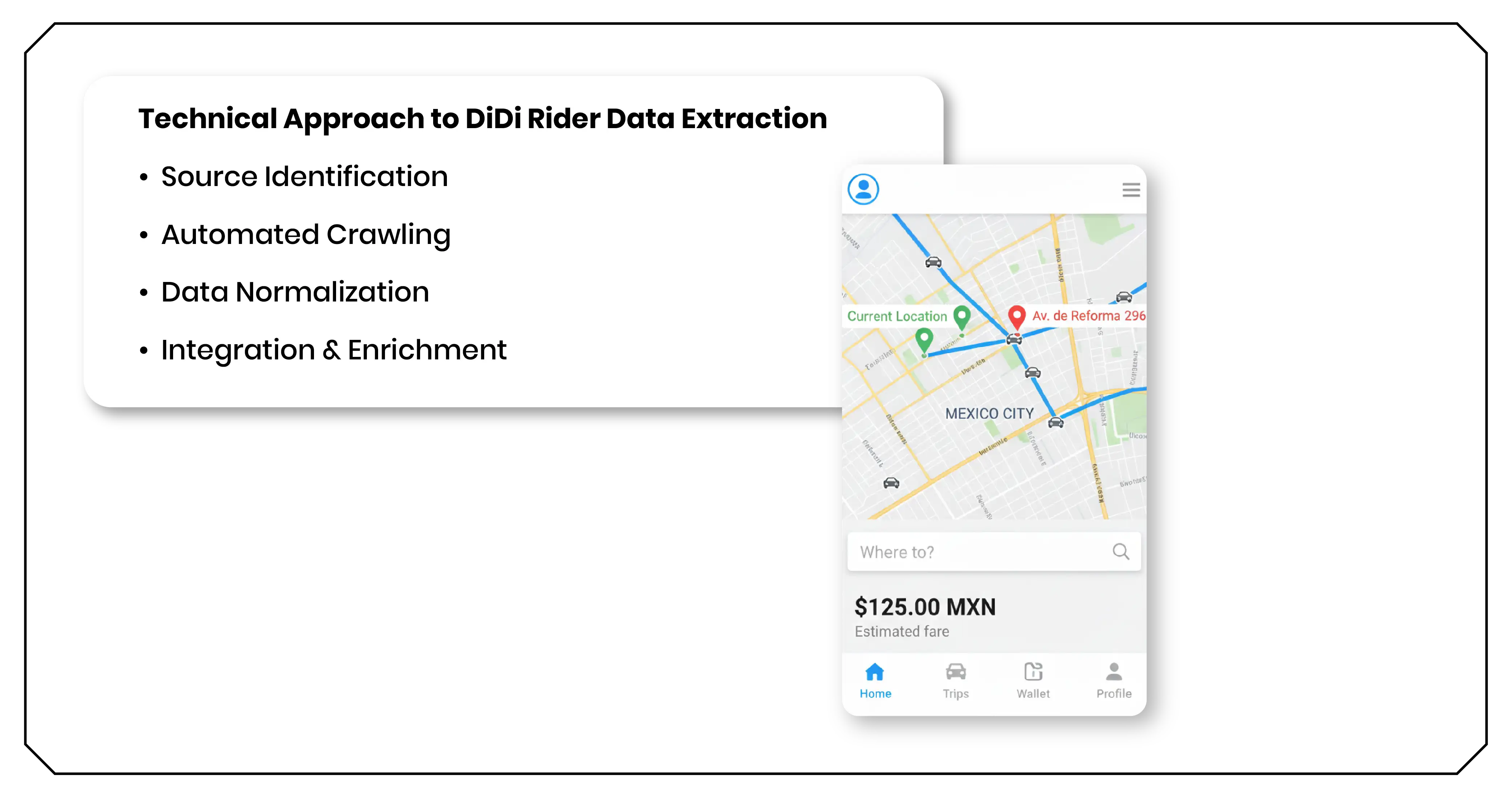How Can Businesses Extract DiDi Rider Data in Mexico to Analyze Ride Trends?

Introduction
In today’s digital mobility landscape, ride-hailing and car rental platforms have become the backbone of urban transportation systems. As Mexico’s urban centers like Mexico City, Guadalajara, and Monterrey continue to witness exponential growth in digital ride-booking activity, the demand to extract DiDi rider data in Mexico has never been greater. Accessing structured and historical data from DiDi’s app and website can unlock powerful insights into pricing patterns, route preferences, demand spikes, and customer sentiment — driving smarter decisions for mobility operators, analysts, and researchers alike.
For companies in transportation, tourism, or analytics, integrating DiDi datasets into decision-making processes is now as vital as understanding market demand. With advanced car rental data scraping services , businesses can uncover competitive intelligence, pricing gaps, and city-level travel trends, offering a distinct advantage in a rapidly evolving ride-hailing economy.
Furthermore, businesses seeking to scrape DiDi booking and pricing data in Mexico can harness this information to identify emerging routes, study hourly fare fluctuations, and monitor supply-demand balance across Mexico’s key metropolitan zones.
In 2025 and beyond, access to such mobility data isn’t just an advantage — it’s a necessity for scalable, efficient, and customer-centric transportation systems.
Why Extracting Data from the DiDi Rider App or Website Matters?
The DiDi Rider platform is a cornerstone of Mexico’s shared mobility sector, connecting millions of users with taxis, private drivers, and rental services. Beyond convenience, DiDi’s datasets contain hidden layers of intelligence that reveal real-time urban mobility patterns, consumer preferences, and operational efficiency.
- Understanding Market Behavior:
By scraping DiDi data, companies gain access to consumer booking frequency, ride duration, fare variation by time and zone, and discount pattern analysis. This helps identify peak-hour surcharges, promotional cycles, and behavioral shifts in customer demand. - Enhancing Pricing Strategies:
Through DiDi Rider car rental data scraping, businesses can capture live pricing data from multiple cities in Mexico, analyze regional variations, and compare them against other ride-hailing platforms like Uber, Bolt, or Cabify. - Real-Time Competitive Intelligence:
Tracking competitor fares, route coverage, and response times provides a critical edge for emerging car rental and mobility startups, ensuring they remain price-competitive and operationally efficient.
Core Advantages of DiDi Rider Data Extraction
Extracting ride-hailing and car rental data provides a direct line into how users interact with urban transportation systems. Here are some of the most impactful benefits:
- Market Forecasting:
Through the process to extract DiDi app reviews and ratings in Mexico, analysts can identify service gaps, regional dissatisfaction, and opportunities for improvement, making this data vital for both local operators and global investors. - Demand Heatmaps:
Mapping data reveals the most popular pick-up and drop-off points in major Mexican cities, helping mobility companies optimize fleet distribution and reduce idle time. - City-Level Insights:
Data segmentation by geography enables companies to compare the ride frequency, fare pricing, and consumer feedback across Mexico City, Monterrey, Puebla, and Guadalajara. - Benchmarking Efficiency:
DiDi’s data allows operators to evaluate average wait times, route optimization effectiveness, and surge pricing triggers — invaluable for process improvement. - Predictive Analytics:
Using data from the DiDi Rider Car Rental Prices Dataset, predictive models can be built to anticipate fare surges, seasonal fluctuations, and consumer loyalty patterns.
Key Data Points Extracted from DiDi Rider App or Website
When extracting ride-hailing data, precision and accuracy are crucial. The following are common categories businesses can target using structured data extraction pipelines:
| Category | Description | Example |
|---|---|---|
| Ride Pricing | Fare per route, surge multipliers, base rate comparison | Fare trend between Mexico City and Guadalajara |
| Ride Duration | Estimated vs actual duration | Average 15% longer travel time during peak hours |
| Booking Patterns | Time, day, and location frequency | 9 AM to 11 AM surge in urban centers |
| Ratings & Reviews | Customer sentiment and satisfaction | 4.6/5 average in Monterrey |
| Driver Performance | Acceptance and cancellation rates | 92% completion rate |
| Promotions & Coupons | Discount type and usage patterns | Weekend discounts higher in Puebla |
Such granular datasets empower businesses to pinpoint inefficiencies, refine route optimization algorithms, and design data-backed loyalty programs.
Leveraging Data for Strategic Insights
- Optimizing Fleet Management:
Through real-time DiDi ride monitoring data in Mexico, companies can gain live visibility into trip density, time efficiency, and idle vehicle ratios. This insight enables mobility operators to rebalance their fleets dynamically, ensuring maximum utilization and customer satisfaction. - Enhancing User Experience:
Data-driven personalization is reshaping the mobility ecosystem. By analyzing ride reviews, ratings, and customer sentiment trends, operators can adapt service standards, improve driver training, and introduce tailored rewards systems that resonate with Mexico’s growing digital rider base. - Route and Demand Mapping:
When businesses engage in car rental data intelligence , they uncover route-level details such as high-frequency travel corridors, demand peaks by hour, and variations in pricing elasticity. This knowledge fuels more efficient pricing and targeted driver deployment. - Competitive Pricing Models:
Comparing data across multiple mobility services using web scraping DiDi for route trends in Mexico enables the development of dynamic pricing models that reflect real-world competition. This approach ensures that both passengers and drivers benefit from balanced, fair-market fares. - Improving Marketing and Targeting:
Ride frequency and user demographics derived from data scraping can guide hyperlocal marketing campaigns. For instance, identifying areas with high late-night rides can inform partnerships with entertainment venues or restaurants for cross-promotional offers.
Technical Approach to DiDi Rider Data Extraction

Extracting structured data from complex, dynamic platforms like DiDi requires robust architecture and compliance-conscious frameworks. Below is a simplified view of our technical process:
- Source Identification:
We identify endpoints (web pages, app interfaces, APIs) that contain public ride and pricing data. - Automated Crawling:
Using advanced bots, our systems continuously capture live data such as fare updates, booking timestamps, and route maps. - Data Normalization:
The collected data is cleaned, standardized, and formatted into usable fields like time, distance, fare type, and route name. - Integration & Enrichment:
Data is merged with external datasets — weather, traffic, event schedules — to provide context to fare and ride fluctuations. - Visualization & Analysis:
Custom dashboards display key metrics such as surge patterns, route profitability, and satisfaction scores in real time.
Case Study: Enhancing Fleet Operations through DiDi Data Extraction
A regional car rental company in Mexico approached us to understand how real-time mobility data could improve vehicle utilization and profitability. Using DiDi Rider Car Rental Data Scraping, they tracked trip frequency, pricing variations, and route density across Mexico City and Guadalajara.
- They identified low-demand zones and reallocated 15% of idle vehicles.
- Adjusted fares during underutilized hours increased bookings by 22%.
- Improved driver scheduling reduced idle time by 18%.
- Customer satisfaction scores rose by 12% due to optimized wait times.
By integrating DiDi data into operational dashboards, the company aligned its fleet operations with actual market demand, saving costs and enhancing service reliability.
Ethical and Legal Considerations
Data extraction must always comply with local and international regulations. When working with ride-hailing datasets, we ensure:
- Only publicly available or consent-based data is collected.
- No personally identifiable information (PII) is stored.
- The process adheres to GDPR and Mexican data privacy laws.
Responsible scraping practices maintain brand integrity while delivering actionable intelligence for business growth.
Emerging Trends in Mexico’s Ride-Hailing Ecosystem
- Rise of Multimodal Mobility:
Ride-hailing services are merging with car rentals, electric bikes, and micro-mobility options. This expansion creates new opportunities for data-driven integration and cross-platform optimization. - AI-Driven Forecasting:
Machine learning models using historical ride data are helping businesses forecast demand by neighborhood, weather condition, and time of day — vital for both drivers and operators. - Sustainability in Urban Transport:
Green initiatives are shaping Mexico’s transportation future. Access to emission data and route optimization insights can guide eco-friendly fleet management strategies. - Shift Toward Dynamic Pricing:
Continuous fare monitoring allows real-time adjustments based on demand elasticity. Operators can leverage predictive analytics to prevent underpricing and maximize peak-hour efficiency. - Integration with Local Businesses:
Ride-hailing data opens doors to partnerships with retail outlets, airports, and restaurants — creating localized ecosystem benefits driven by accurate route analytics.
Data-Driven Insights for 2025–2026
With urban populations growing rapidly, demand for intelligent transportation analytics will skyrocket. Businesses that effectively extract, process, and analyze DiDi’s mobility data can anticipate consumer behavior shifts long before competitors.
| Focus Area | Impact |
|---|---|
| Smart Cities | Integration of ride data with municipal transport planning |
| AI Prediction | Improved ride-time and price forecasting accuracy |
| Data Monetization | Ride-hailing data becomes a revenue stream for partners |
| Personalized Marketing | Contextualized offers based on user behavior |
| Sustainability | Tracking carbon impact per route |
By combining ride data with broader mobility datasets, businesses and researchers can paint a complete picture of Mexico’s transportation transformation.
How Travel Scrape Can Help You?
Our data scraping services are designed to deliver precision, scale, and actionable insights. Whether it’s pricing data, booking frequency, or driver analytics, we ensure seamless extraction and transformation into digestible intelligence formats.
- End-to-End Data Collection:
Comprehensive access to ride, fare, and route datasets. - Real-Time Data Feeds:
Continuous updates for current market visibility. - Custom Dashboard Solutions:
Visual analytics for strategic decision-making. - Predictive Modeling Integration:
Turn historical datasets into forecasting tools.
The future of urban mobility in Mexico hinges on data. As cities evolve and digital ride platforms multiply, the ability to extract and interpret actionable insights will define competitive success. Companies that rely on structured mobility datasets will innovate faster, adapt quicker, and serve smarter.
By leveraging DiDi trip comparison dataset Mexico, businesses can benchmark fares, analyze performance, and refine strategies. Implementing systems to Scrape DiDi Rider app data allows for constant optimization of service models, driver allocation, and customer engagement.
Moreover, the Didi Rider Car Rental Locations Dataset empowers companies to monitor geographic reach, evaluate performance per region, and tailor marketing to hyperlocal audiences. Together, these capabilities ensure that mobility brands stay agile, efficient, and customer-first.
As 2025 and beyond usher in a new era of smart mobility, data extraction from DiDi and other platforms will remain the cornerstone of strategic transportation planning — shaping the future of connected, data-driven travel across Mexico and beyond.
Ready to elevate your travel business with cutting-edge data insights? Scrape Aggregated Flight Fares to identify competitive rates and optimize your revenue strategies efficiently. Discover emerging opportunities with tools to Extract Travel Website Data, leveraging comprehensive data to forecast market shifts and enhance your service offerings. Real-Time Travel App Data Scraping Services helps stay ahead of competitors, gaining instant insights into bookings, promotions, and customer behavior across multiple platforms. Get in touch with Travel Scrape today to explore how our end-to-end data solutions can uncover new revenue streams, enhance your offerings, and strengthen your competitive edge in the travel market.
.webp)
.webp)